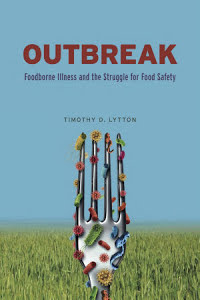
Review of Timothy D. Lytton’s Outbreak: Foodborne Illness and the Struggle for Food Safety
0 Comments
Lytton laments the fact that investigations into most pathogen outbreaks do not result in the identification of the source of the contamination. Without a finding, food safety is reduced to speculation, and improvements cannot be realized. Lytton urges “Dedicating more public resources to outbreak investigations… [to] reduce uncertainty about the root causes of foodborne illness.”
One of the overlooked potential sources is “transitional grounds” – farmland in transition from conventional to organic farming. Organic farming, while reducing chemical risks, increases microbiological risks. “If not properly treated, [organic fertilizers] can harbor microorganisms, including bacterial pathogens such as Salmonella, E. coli, and Listeria.” While conventional pesticides take the guess work out of farming, inexperienced organic farmers – those farming “transitional grounds” – may be prone to mistakes in applying organic fertilizers that could result in pathogen contamination.
Another of Lytton’s observations concerns well-meaning attempts to improve practices and processes. In their attempts to win the last war, food producers sometimes wind up starting a new one. When dump tanks were found to be “hot spots” for Salmonella contamination, a Colorado cantaloupe packinghouse turned to a spray wash system that led to a deadly Listeria monocytogenes outbreak. Lytton notes that “without antimicrobial solution added to the wash water, the spray wash spread bacterial contamination from melon to melon and dispersed it all over the processing equipment.”
Further complicating the matter was the audit performed on the facility. A third-party auditor who conducted a standards-based inspection of that packinghouse was required by the scope of the audit to score it based on the auditees’ observance of FDA regulations, not on FDA’s non-binding guidance. Therefore, the auditor made note of examples of the failure to follow FDA guidance, but did not downscore the audit.
But the differences between food safety regulations and guidance are not always clear. FDA guidance on antimicrobials in wash water stated that single-pass wash systems using potable water are not required to add an antimicrobial solution, and, in this case, even if the FDA had stated it should be used, that statement was “non-binding guidance.”
If FDA expects food producers to follow a prescribed practice, they need to make that practice a regulation, not “non-binding guidance.” The incident above could have been mitigated or potentially avoided entirely if the FDA regulation called for antimicrobial solution in spray wash systems, but since it did not – since potable water was an acceptable alternative – the cantaloupe packinghouse chose not to follow the non-binding guidance and didn’t add an antimicrobial. A deadly Listeria outbreak was the end result.
Ironically, in the aftermath of the outbreak, the FDA claimed that the packinghouse should have followed their guidance, and when they were discovered not to have done so, they were subjected to condemnation, accusations of rampant disregard for food safety, and, eventually, criminal prosecution.
This also created a Catch-22 for the auditor. Buyers, the recipients of most third-party audits, “generally require that audits be scored”, but, “scores divert attention from the detailed analysis of a facility’s food safety policies and practices…”, and are not always an accurate reflection of the auditees’ food safety performance. As the audit certificate clearly stated, “Please refer to the audit report to read scope, scoring and commentary details.”
After the outbreak, the large retailers that previously demanded audit scores as an easy way to gauge supplier performance complained that the auditor’s scores oversold the packinghouse’s performance. Thus, the auditor who identified the cantaloupe packer’s failure to add an anti-microbial to its spray wash system on five different occasions in the audit, but did not downscore that omission, was accused of incompetence by the very people who failed to read his audit and heed his warning.
Lytton makes another major recommendation: “Technological advances in digitizing supply chain management information are likely to improve the capacity of investigations to identify the root causes of an outbreak and the ability of responsible companies to effectively recall contaminated products to stem the spread of infection.” Lytton makes clear that all entities within supply chains should utilize supply chain management systems that can sort and filter audit, lab, and other data in granular fashion.

